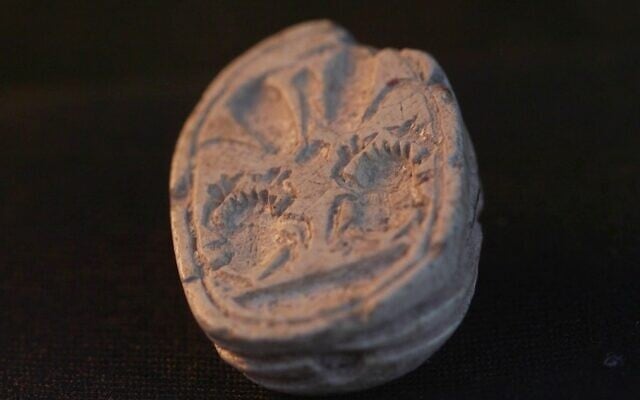A three -year -old Israeli girl found a Canaani amulet in the form of a beetle dating from 3,800 years on the Tel Azeka site near Bet Shemesh, the Israel Antiquities (IAA) Antiquities (IAA) announced on Tuesday.
Ziv Nitzan, of Moshav Ramot Meir, hiked with his parents and two older sisters at the foot of the hill where the archaeological site is located when she picked up what seemed to be a small stone.
“We were walking along the way, then Ziv leaned himself – and all the stones around her, she picked up this particular stone,” said Omer Nitzan, Ziv’s sister, in a press release sent by IAA. “When she rubbed it and removed the sand, we saw that something was different. I called my parents to come and see the beautiful stone, and we realized that we had discovered an archaeological discovery! We immediately reported this to the authority of Israel Antiquities. ”
The scarab amulets retrace their origins in ancient Egypt, where the beetles were venerated as sacred renewal symbols. The Egyptians believed that these insects embodied a new life, while they were pleating their eggs inside the dung balls which they rolled – apparently spending the life of the decomposition.
“The scarabes were used during this period as a seals and as amulets,” said Dr. Daphna Ben-Tor, an expert in the field, in a press release. “They were found in the tombs, in public buildings and in private houses. Sometimes they carry symbols and messages that reflect religious beliefs or status. ”
Ben -Tor examined the artefact found in Tel Azeka and determined its cultural affiliation with the Canaanites, an old people recorded throughout the Bible and in historical documents up to 3,500 years – as well as older archaeological discoveries – as a group of peoples living throughout the Levant who were led by their own urban / states kings.

From right to left – University of Tel Aviv, Professor Oded Lipschits, Noga, Ziv and Omer Nitzan, and the archaeologist of the Antiquities Authority Semyon Gendler. (Emil Aladjem / Israel Antiquities Authority)
Like Azeka is mentioned in the Bible as the location of the emblematic battle between David and the giant Philistin Goliath (Samuel I 17: 1).
The site has been searched for 15 years by researchers from the University of Tel Aviv (TAU).
“The results of the excavations show that during the medium bronze and late bronze (2000-1000 BCE), here in Tel Azeka, prospered one of the most important cities of the low Judeal Lands,” said TAU professor Oded Lipschits, director of excavations at Tel Azeka. “The scarab found by Ziv joins a long list of Egyptian and Canaanite discoveries discovered here, which attest close ties and cultural influences between Canaan and Egypt during this period.”
https://www.youtube.com/watch?v=hntkmsqvcgw
The Scarab will be presented in a special IAA Passover exhibition at the Jay National Campus and Jeanie Schottenstein for the archeology of Israel in Jerusalem, alongside other Egyptian and Old Canary discoveries.
“In our public tours, we will present impressive objects for the first time, in particular pharaohs of the pharaohs, Egyptian statues, ritual ships and evidence of Egyptian cultural influence in the land of Israel,” said the director of IAA Eli Escododo in a press release.

Ziv Nitzan, three, from Moshav Ramot Meir, finds a Canaanite scarab amulette dating 3,800 years ago in Tel Azeka in March 2025. (Emil Aladjem / Israel Antiquities Authority)
The IAA said that she had presented a certificate of appreciation to Ziv and her family.



